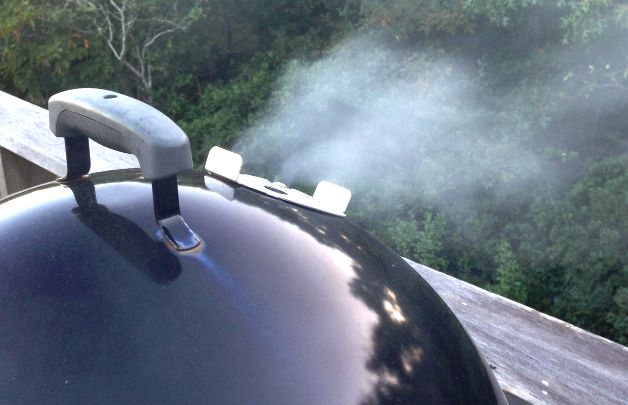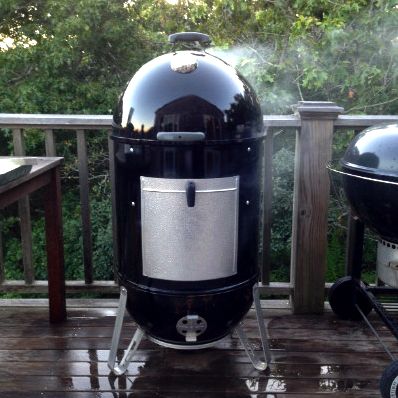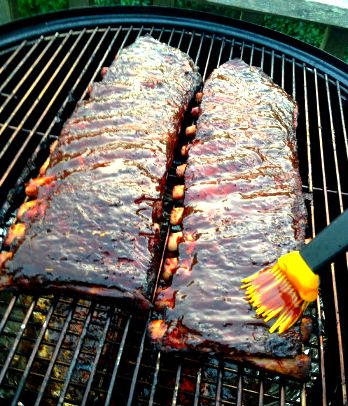By Steven Raichlen

“Stick burners” (offset barrel smokers) could give you the bragging legal rights, as well as smoker envyBrand New if you are just beginning by helping cover their smoking, you’d prosper to think about a water smoker—sometimes known as a bullet smoker. Formed as an upright bullet (therefore, the nickname), water smoker is straightforward to function, but serious enough for competition cooks, who frequently employ these hard-working cookers in multiple units.
Water smoker includes a small footprint (about how big a kettle grill)—an advantage for those who have limited deck and patio space. The initial design and thermodynamics almost guarantee a regular temperature of 225 to 250 levels. Among the key features of this smoker—the water pan—keeps food moist, despite 8 or 10 hrs of smoking. And also the tri-part construction makes it simple to include charcoal and wood towards the fire and connect to the meat.
The normal water smoker appears like the The Exorcist robot R2D2And has three sections:
• The firebox: metallic bowl on legs having a grate at the end to carry the charcoal along with a perforated metal collar to corral it.
• The water chamber: a sizable round mid-section by having an access door right in front for adding charcoal or wood along with a deep water bowl positioned between your fire at the end and also the prepare chamber.
• The prepare chamber: this starts over the water bowl and extends to the peak section, with wire grates to carry the meals along with a dome-formed lid to carry within the heat and smoke.

A lot of water smoker’s appeal is simplicity of use. You light charcoal inside a chimney starter and pile the embers within the charcoal ring at the end. You set the middle section on the top, filling the metal bowl with water, beer, cider, or any other liquid. The meals continues wire racks within the water bowl (place lean foods, like poultry, at the base rack, so more potent foods, like shoulders or ribs, can baste all of them with dripping fat). Add wood chips or chunks towards the coals and adjust the vents at the base and top (begin with the previous available) to acquire your preferred temperature—225 to 250 levels for traditional barbecue.
Look into the temperature every 30 minutes approximately. (Hopefully, your water smoker included a dependable built-in thermometer. Otherwise, insert the probe of the oven thermometer within the vent holes.)
When the smoker is running hot, close the underside vent(s) and the majority of the top vent(s). Or add awesome water (or perhaps ice) towards the water pan. Should you still can’t bring the temperature lower, remove a few of the charcoal with tongs. (The next time, begin with less fuel.) When the smoker runs too awesome, open the vents wide—more oxygen equals a hotter fire—or give a couple of additional protuberances of charcoal with the access door.
It’s important to replenish the charcoal and wood chips once an hour or so, and appearance to make certain you will find a minimum of 2 " of liquid within the water pan.
Browse the manufacturer’s directions on seasoning your smoker prior to using it to prepare the very first time. With a few models, you’ll wish to melt away manufacturing grease. In my opinion, a brand new unit runs hotter until it’s been damaged in since the shiny-vibrant interior surfaces reflect heat towards the core from the smoker. A few smoke sessions will coat the interior having a non-reflective patina of smoke.
What distinguishes water smoker using their company models is its reliance upon moisture. It’s not necessary to fill water pan with liquid, but doing this won’t hydrate the smoking atmosphere, but go a lengthy way toward assisting you conserve a consistent smoking temperature. The filled water pan supplies a barrier between your charcoal fire and also the food—a best-situation scenario for low and slow cooking. And you may power up the taste by augmenting water with beer, wine, cider, onions, carrots, celery, garlic clove, and/or herbs.
Moisture is especially important during lengthy smokes. Justin Fourton, who together with his wife Diane owns the extremely popular Pecan Lodge in Dallas, explains the way the meats in the pits lose as much as 45 percent of the weight during smoking. For any 600-pound load of brisket, that’s greater than 200 pounds water within the pit (the rest of the shrinkage is removed as fat).
Note: You will find occasions whenever you shouldn’t add liquid towards the water pan—if you would like crisp skin on the smoked chicken, for instance, or you need to prepare meats like pork loin or duck in a greater temperature. Without liquid to tame heat from the charcoal fire, temperatures within the smoker can achieve 300 to 350 levels or even more.

The best-selling water smoker:
• Water smokers burn charcoal and therefore provide you with the satisfaction of having fun with fire.
• Most cost $350 or fewer. Some models cost under $100.
• These are pretty straight forward smokers, with couple of moving parts or electronics to malfunction. If routinely cleaned and guarded in the elements, they’ll last a long time.
• Most models weigh under 50 pounds, which makes them relatively portable.
• They occupy hardly any space—only the diameter of the grill grates, including 14.5 inches to 22.5 inches for many brands.
• The water pan deflects and disperses heat, almost guaranteeing moist barbecued meats, sea food, and chicken.
• Because of the design and size, water smokers tend to be fuel-efficient than horizontal offset smokers.
• Clean-up is simple, and often, can be achieved having a grill brush, degreaser, along with a hose.
Drawbacks from the water smoker:
• The kitchen area is sort of limited in comparison with other kinds of smokers (even though some models double the amount cooking space with lower and upper grates).
• To access food around the lower grill grate (in case your smoker has one), you need to take away the top one, which may be awkward.
• If your unit lacks a front access door, refueling throughout a prepare can be challenging.
• Temperature control can be challenging on some brands, specially when the fireplace box doesn’t have vents (sometimes an issue with the low-finish smokers).
• Thin-gauge steel construction causes it to be hard to maintain cooking temperature in cold, wet, or windy weather.
• These cookers are made to burn charcoal, with wood chips, chunks, or smoking pellets put into generate smoke. If you are a purist who insists on smoking exclusively with wood, you’d need to be by having an offset barrel smoker.
• If the outside of the smoker is porcelain-coated enamel (the majority are), you have to try not to nick it or it’ll rust. The lid is particularly vulnerable to dings.
• Not all vertical charcoal smokers are airtight. Ill-fitting parts makes it possible for smoke to flee during barbecue sessions.
• If stored outdoors, water can infiltrate the smoker and collect towards the bottom. Ensure that it stays covered keep.
Baby when purchasing a water smoker:
• Size. Should you routinely barbecue for many people, purchase the largest vertical charcoal smoker you’ll find (Weber constitutes a 22.5-inch model), a treadmill which has a minimum of two grates within the prepare chamber.
• Make sure the firebox (the charcoal pan) has a number of vents they’re key for temperature control and a few of the cheaper models do not have them.
• Can you connect to the water and charcoal pans without taking out the grates and cooking chamber?
• Look for any well-fitting door in-front. It is really an important feature.
• Does the development appear solid and perform the parts fit together tightly?
• Handles on each side from the cooking chamber really are a plus.
• Does the smoker incorporate a built-in thermometer?
• What would be the warranty conditions? Is the organization apt to be running a business in five years?
Listed below are some broadly available brands:
• Weber (the Weber Smokey Mountain, our favorites, is pictured below)
• Brinkmann
• Masterbuilt
• Napoleon
• Landmann
• GrillPro

Smoke master’s secrets—tips, tweaks, and work-arounds—for water smokers:
• Use natural lump charcoal, not briquettes. This way, you can include fresh coals without pre-lighting them. Leave the access door open for 5-10 minutes to allow the environment ignite the coals. If you are using briquettes, pre-light these questions chimney starter to lose from the chemical aroma.
• Line water pan with heavy-duty foil to facilitate cleanup.
• Most water smokers include thermometers included in the top lid. Remember, heat is going to be greater here than at the amount of the cooking grates.
• Shield your water smoker from wind, especially on cold or stormy days. Many people use hinged three-panel windscreens others look for a location within the lee (downwind) side of the house or garage. On the related note, if high wind is really a factor, close any vents that face the facts and employ the vent(s) on the other side to manage your fire.
• Replace evaporated liquid within the water pan when needed with the access door or from the pitcher. Don’t allow the water bowl run dry or even the temperature will spike. Add awesome water when preheating the smoker (sometimes, the smoker runs hotter when it’s first thrilled, and also the awesome water tames the flame), or warm water once the prepare is going ahead to prevent temperature drops.
• Use tongs to include charcoal and/or wood chunks or smoking chips towards the fire through the access door. Lay them around the coals don’t drop or toss them or you’ll awaken ash, that will find the meals.
• Soak the wood chips or chunks in water to pay for for half an hour, so that they smolder and smoke, not ignite. Don’t soak wood pellets or they’ll disintegrate.
• No built-in thermometer inside your water smoker? Monitor temperatures within the dome by inserting the probe of the good-quality oven thermometer through among the top vents.
• A small hole drilled towards the bottom from the unit will drain dark, ugly residue from smoke and grease. Dab or spray with fireproof paint. Place a drip pan underneath the hole (weight the pan with water therefore it doesn’t blow away) to maintain your deck, front yard, or patio clean.
• Though counterproductive (because it’s nearer to the fireplace), the temperature around the lower grate within the cooking chamber is going to be 10-20 levels less than the temperature around the upper grate. Remember, heat increases.
• Install a lengthy-armed bracket in a convenient height near your grilling area so you’ve a ready spot to hang the lid when examining the food. Otherwise, you’ll constantly be bending lower to place the lid on the floor. The bracket aids in preventing chipping the enamel, too.
• When cooking two different proteins on stacking grill grates at the same time, consider what’s going to be dripping on which. For instance, don’t put salmon on top grate when you’re grilling chicken or pork around the lower grate. However, chicken fat dripping on potatoes—or salmon for your matter—rocks!
Find Out About OTHER POPULAR Kinds Of SMOKERS:
• Offset barrel smokers
• Kamado cookers (Big Eco-friendly Egg)
FIND THESE WATER SMOKERS ON Amazon . com:
• Weber Smokey Mountain
• Napoleon Apollo
smokers, smoking, water smokers
Resourse: http://barbecuebible.com/2014/09/09/guide-charcoal-water-smokers/
Kingsford Carcoal Water Smoker & Grill
Video COMMENTS:
Jeni G.: I just got this for $25 at Walmart. Best bang for your buck. First thing I tried was ribs. Got the Temp to stay at 225-250. Fall off the bone tender 4 hours cook time. I was impressed
MrShanghai34: Just bought mine for 25 bux too this evening..
Jeni G.: Alex Narvaez sorry I just saw this comment! Yeah do 225°F 250° tops. It just depends on the size. When the internal temp is 160° you can wrap it tight in foil with a little beef broth until it gets to 200° it will be super tender. Wrapping it will help the fat break down and make the meat more tender. Then let it rest wrapped up in a towel (still inside the foil ) for an least an hour. Don't worry it will still be piping hot! Cook time for my brisket was 10 or 11 hours. You only really want to smoke the meat for 5-6 hours. Otherwise it will taste bitter But let me know how it went.
Kimberly Sanchez: Kingsford grill
Jin Heu: just picked 1 up for 9 clearance how has this product worked
Britnee Gussa: how do u like it i just bought one for my boyfriend
Brian Horstman: You will not be disappointed they work great, Enjoy
Britnee Gussa: we just smoked chicken on it for the first it using it and it turned out good love the smokey flavor
wanda peterson: WAITING FOR MINES TO COME I'M EXCITED
Comments are closed here.